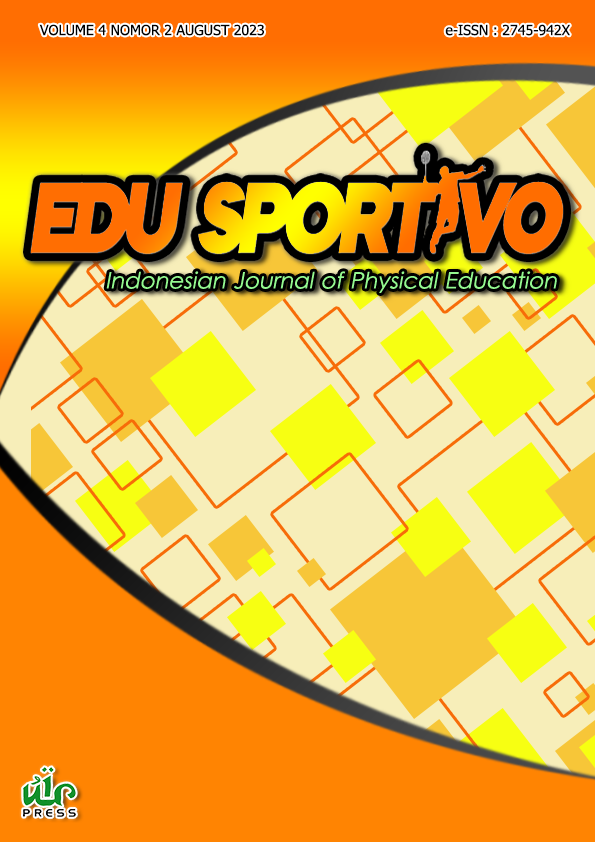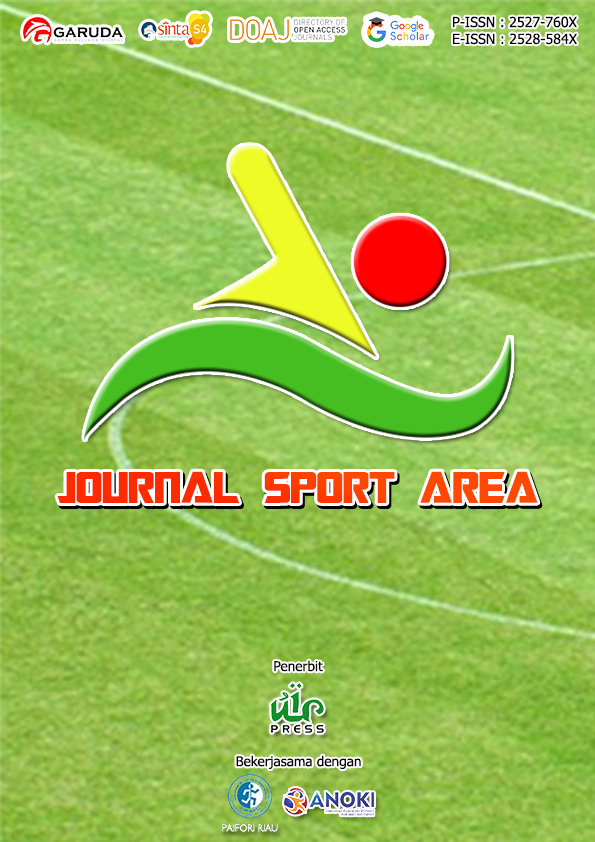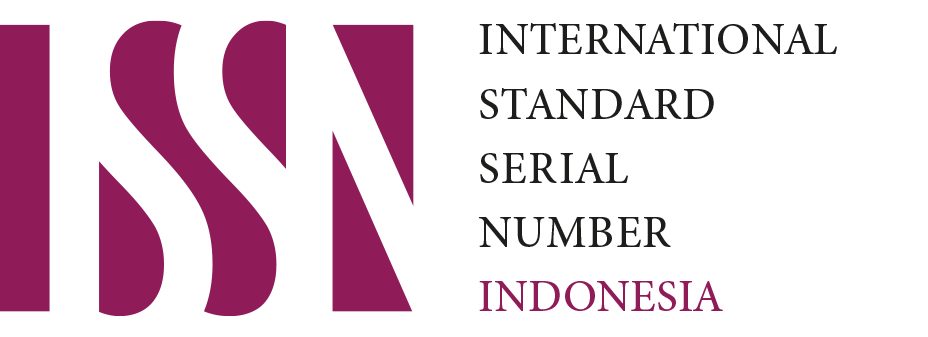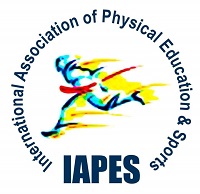Unlocking the future of swimming education: A breakthrough in pull buoy development as an innovative learning medium
Keywords:
Pull Buoy, ADDIE design, learning media, swimmingAbstract
The effectiveness of the learning process in swimming greatly depends on innovative learning media. This research aims to develop and produce a pull buoy as an effective swimming learning medium. This research uses the ADDIE model for Research and Development (R&D) research. The study was conducted at Tadulako University with the collaboration of swimming material experts, instructional design experts, and learning media experts. The research involved 40 students enrolled in swimming learning courses, and data were collected through observation and questionnaires. The assessment by learning design and learning media experts revealed that the developed Pull Buoy achieved high-quality learning standards. Furthermore, both small group and large group evaluations demonstrated feasibility and outstanding performance. The research offers valuable insights and recommendations for future researchers to refine and expand the Pull Buoy's development, suggesting customization of its colour combinations and sizes to suit different age groups of users and advocating for a larger pool of subjects to yield more comprehensive results and insights into the learning medium's impact.
Downloads
References
Andriani, A., Dewi, I., & Sagala, P. N. (2019). Development of blended learning media using the mentimeter application to improve mathematics creative thinking skills. Journal of Physics: Conference Series, 1188(1), 1-7. https://doi.org/10.1088/1742-6596/1188/1/012112 DOI: https://doi.org/10.1088/1742-6596/1188/1/012112
Aprianto, W. N., Sir, I., & Amir, A. (2022). Practice of Audio-Visual Learning Media to Grow the Motivation of MI Kenongomulyo Students’ Learning. Indonesian Journal of Research and Educational Review, 1(2), 137–144. https://doi.org/10.51574/ijrer.v1i2.271
Aprilianingsih, N. K. A. S. ., & Asril, N. M. . (2022). Video Learning Oriented to the Value of Caring for the Environment. MIMBAR PGSD Undiksha, 10(2), 386–394. https://doi.org/10.23887/jjpgsd.v10i2.48832 DOI: https://doi.org/10.23887/jjpgsd.v10i2.48832
Armen, M., & Rahmadani, A. F. (2019). Development of Learning Media Swimming Freestyle Based on Macromedia Flash 8 on Students Class VIII SMPN 2 Padang. KnE Social Sciences, 3(15), 205-221. https://doi.org/10.18502/kss.v3i15.4368 DOI: https://doi.org/10.18502/kss.v3i15.4368
Azizah, N., & Syarifah. (2021). Desain Pembelajaran ADDIE (Analysis, Design, Development, Implementation, and Evaluation) E-Learning Pada Materi Sejarah Kebudayaan Islam. Jurnal Pendidikan Islam UHAMKA, 12(2), 109–120. https://doi.org/10.22236/jpi.v12i2.7934
Bagchegi, O., Tabatabaeichehr, M., Lashkardoost, H., & Mortazavi, H. (2021). The Effect of Education Based on Kolb’s Learning Style on Selfcare Behaviors of the Elderly with Type II Diabetes: A Randomized, Clinical Trial. Ethiopian Journal of Health Sciences, 31(6), 1277–1286. https://doi.org/10.4314/ejhs.v31i6.24
Borich, G. D. (2017). Effective Teaching Methods: Research-Based Practice. In Pearson Education, Inc. (8th ed.).
Branch, R. M., & Dousay, T. A. (2015). Survey of Instructional Design Models (D. R. Walling (ed.); 5th ed.). Association for Educational Communications and Technology.
Chandran, R., Negar, A., Koo, S. H., Lim, Y. Y., Lai, J. Bin, Tan, A. K. L., & Singh, P. A. (2020). Simulation of Bleeding Airways in Cadavers: New Models for Experiential Learning. Open Journal of Anesthesiology, 10(05), 190–202. https://doi.org/10.4236/ojanes.2020.105017 DOI: https://doi.org/10.4236/ojanes.2020.105017
Charmas, M., & Gromisz, W. (2019). Effect of 12-week swimming training on body composition in young women. International Journal of Environmental Research and Public Health, 16(3), 1-13. https://doi.org/10.3390/ijerph16030346 DOI: https://doi.org/10.3390/ijerph16030346
Chen, X., Liu, B., & Le, G. (2023). A Multi-Objective Optimization of the Anchor-Last Deployment of the Marine Submersible Buoy System Based on the Particle Swarm Optimization Algorithm. Journal of Marine Science and Engineering, 11(7), 1305. https://doi.org/10.3390/jmse11071305 DOI: https://doi.org/10.3390/jmse11071305
Cornelius, F. H., & Wilson, L. (2021). Educational Technology - Certifed Nurse Educator (CNE®) Review, Fourth Edition. Springer. https://doi.org/10.4324/9781315854816-16 DOI: https://doi.org/10.4324/9781315854816-16
Crocker, L. (2015). Content Validity. International Encyclopedia of the Social & Behavioral Sciences: Second Edition, 2015, 774–777. https://doi.org/10.1016/B978-0-08-097086-8.44011-0 DOI: https://doi.org/10.1016/B978-0-08-097086-8.44011-0
Dewi, I. N., Utami, S. D., Effendi, I., Ramdani, A., & Rohyani, I. S. (2020). The Effectiveness of Biology Learning-Local Genius Program of Mount Rinjani Area to Improve the Generic Skills. International Journal of Instruction, 14(1), 265–282. https://doi.org/10.29333/IJI.2021.14116A DOI: https://doi.org/10.29333/iji.2021.14116a
Dhani, D. P., Zubaida, I., Triprayoga, R., & Nur Wahyudi, A. (2022). Penggunaan Media Pembelajaran Model Gerakan Terhadap Hasil Belajar Renang Gaya Dada. Jurnal Pendidikan Modern, 7(3), 128–134. https://doi.org/10.37471/jpm.v7i3.492 DOI: https://doi.org/10.37471/jpm.v7i3.492
Dorofieieva, O., Yarymbash, K., Skrypchenko, I., Pavlović, R., & Badicu, G. (2019). The effect of recreational swimming on the health of students with poor somatic health in physical education classes at university. Journal of Functional Morphology and Kinesiology, 4(3), 1-9. https://doi.org/10.3390/jfmk4030059 DOI: https://doi.org/10.3390/jfmk4030059
Duijn, T. V., Ng, J. L., Burnay, C., Anderson, N., Uehara, L., Cocker, K., & Button, C. (2021). The Influence of Equipment and Environment on Children and Young Adults Learning Aquatic Skills. Frontiers in Psychology, 12, 1-18. https://doi.org/10.3389/fpsyg.2021.733489 DOI: https://doi.org/10.3389/fpsyg.2021.733489
Ediyani, M., Hayati, U., Salwa, S., Samsul, S., Nursiah, N., & Fauzi, M. B. (2020). Study on Development of Learning Media. Budapest International Research and Critics Institute (BIRCI-Journal): Humanities and Social Sciences, 3(2), 1336–1342. https://doi.org/10.33258/birci.v3i2.989 DOI: https://doi.org/10.33258/birci.v3i2.989
Elida, T., Nugroho, W., & Suyudi, I. (2012). Cost Effectiveness of Web based Learning. Procedia - Social and Behavioral Sciences, 65(ICIBSoS), 1071–1076. https://doi.org/10.1016/j.sbspro.2012.11.373 DOI: https://doi.org/10.1016/j.sbspro.2012.11.373
Firdausi, D. K. A. (2018). Peningkatan Hasil Belajar Renang Gaya Bebas. JUARA : Jurnal Olahraga, 3(1), 51–61. https://doi.org/10.33222/juara.v3i1.216 DOI: https://doi.org/10.33222/juara.v3i1.216
Ginting, I. R., Harwanto, H., & Hakim, L. (2020). Model Permainan Air “Swimming Couple With Pull Buoy” Untuk Meningkatkan Kecepatan Renang Gaya Bebas. MENDIDIK: Jurnal Kajian Pendidikan dan Pengajaran, 6(2), 146–151. https://doi.org/10.30653/003.202062.135 DOI: https://doi.org/10.30653/003.202062.135
González, B. M. (2022). Instructional design according to the ADDIE model in initial teacher training. Apertura, 14(1), 80–95. https://doi.org/10.32870/ap.v14n1.2160 DOI: https://doi.org/10.32870/Ap.v14n1.2160
Gusmida, R., & Islami, N. (2017). The Development of Learning Media for the Kinetic Theory of Gases Using the ADDIE Model with Augmented Reality. Journal of Educational Sciences, 1(1), 1-10. https://doi.org/10.31258/jes.1.1.p.1-10 DOI: https://doi.org/10.31258/jes.1.1.p.1-10
Ifani, P. N., Nurpahmi, S., & Ahmad, D. (2020). Developing Inquiry Learning Model-Based English Instructional Materials for the Seventh Grade of Junior High School. English Language Teaching for EFL Learners, 2(2), 95-106. https://doi.org/10.24252/elties.v2i2.11252 DOI: https://doi.org/10.24252/elties.v2i2.11252
Inayati, R., Handayani, S., Kustiandi, J., Haryono, A., Wahyono, H., & . S. (2018). The Analysis of the Difficulty in Learning Economics Subject Experienced By Students of Favored State Senior High Schools in City of Malang. KnE Social Sciences, 3(3), 195-210. https://doi.org/10.18502/kss.v3i3.1884 DOI: https://doi.org/10.18502/kss.v3i3.1884
Johnes, J., Portela, M., & Thanassoulis, E. (2017). Efficiency in education. Journal of the Operational Research Society, 68(4), 331–338. https://doi.org/10.1057/s41274-016-0109-z DOI: https://doi.org/10.1057/s41274-016-0109-z
Kang, Y.-C., & Chen, C.-Y. (2016). The Study of Evaluation the Quality of the Mobile Experiential Learning Model. Creative Education, 7(16), 2490–2503. https://doi.org/10.4236/ce.2016.716236 DOI: https://doi.org/10.4236/ce.2016.716236
Kim, S., Song, K., Lockee, B., & Burton, J. (2020). Gamification in Learning and Education: Enjoy Learning Like Gaming. Springer. https://doi.org/10.1080/10.1007/978-3-319-47283-6
Kintu, M. J., Zhu, C., & Kagambe, E. (2017). Blended learning effectiveness: the relationship between student characteristics, design features and outcomes. International Journal of Educational Technology in Higher Education, 14(1), 1-20. https://doi.org/10.1186/s41239-017-0043-4 DOI: https://doi.org/10.1186/s41239-017-0043-4
Kolb, D. A. (2015). Lifelong Learning and Integrative Development. In Experiential learning : experience as the source of learning and development (2nd ed.). Pearson Education, Inc.
Köroğlu, M., & Yiğiter, K. (2016). Effects of Swimming Training on Stress Levels of the Students Aged 11-13. Universal Journal of Educational Research, 4(8), 1881–1884. https://doi.org/10.13189/ujer.2016.040818 DOI: https://doi.org/10.13189/ujer.2016.040818
Lee, B.-A., & Oh, D.-J. (2015). Effect of regular swimming exercise on the physical composition, strength, and blood lipid of middle-aged women. Journal of Exercise Rehabilitation, 11(5), 266–271. https://doi.org/10.12965/jer.150242 DOI: https://doi.org/10.12965/jer.150242
Lu, Y., & Ye, H. (2019). The effect of continuous swimming on physical health. Proceedings of the 2019 4th International Conference on Modern Management, Education Technology and Social Science (MMETSS 2019), 333–337. https://doi.org/10.2991/mmetss-19.2019.65 DOI: https://doi.org/10.2991/mmetss-19.2019.65
Moshtari, M., & Safarpour, A. (2023). Challenges and strategies for the internationalization of higher education in low-income East African countries. Higher Education, 2023, 1-21. https://doi.org/10.1007/s10734-023-00994-1 DOI: https://doi.org/10.1007/s10734-023-00994-1
Nasrullah, R. F., Maksum, A., & Priambodo, A. (2022). The Effect of Hypnotherapy on Anxiety and Motivation in Learning to Swim. Jendela Olahraga, 7(2), 107–118. https://doi.org/10.26877/jo.v7i2.12001 DOI: https://doi.org/10.26877/jo.v7i2.12001
Ozcan, M. (2021). Factors Affecting Students’ Academic Achievement according to the Teachers’ Opinion. Education Reform Journal, 6(1), 1–18. https://doi.org/10.22596/erj2021.06.01.1.18 DOI: https://doi.org/10.22596/erj2021.06.01.1.18
Papadimitriou, K., & Loupos, D. (2021). The effect of an alternative swimming learning program on skills, technique, performance, and salivary cortisol concentration at primary school ages novice swimmers. Healthcare (Switzerland), 9(9), 1-14. https://doi.org/10.3390/healthcare9091234 DOI: https://doi.org/10.3390/healthcare9091234
Priana, A. (2019). Pengaruh Alat Bantu Latihan Pull Buoy Terhadap Prestasi Renang Gaya Dada. Journal of SPORT (Sport, Physical Education, Organization, Recreation, and Training), 3(1), 9–14. https://doi.org/10.37058/sport.v3i1.745 DOI: https://doi.org/10.37058/sport.v3i1.745
Puspitarini, Y. D., & Hanif, M. (2019). Using Learning Media to Increase Learning Motivation in Elementary School. Anatolian Journal of Education, 4(2), 53–60. https://doi.org/10.29333/aje.2019.426a DOI: https://doi.org/10.29333/aje.2019.426a
Rahmandhani, H. N., & Utami, E. (2022). Comparative Analysis of ADDIE and Assure Models in Designing Learning Media Applications. Jurnal Educative: Journal of Educational Studies, 7(2), 123–138. http://doi.org/10.30983/educative.v7i2.6005 DOI: https://doi.org/10.30983/educative.v7i2.6005
Ramli, F. A. M., & Ahmad, Y. (2022). Validity and Reliability of Shark Buoy Swimming Aid. International Journal of Human Movement and Sports Sciences, 10(4), 36–40. https://doi.org/10.13189/saj.2022.101306 DOI: https://doi.org/10.13189/saj.2022.101306
Reiser, R. A., & Dempsey, J. V. (2018). Trends and Issues in Instructional Design and Technology (4th ed.). Pearson.
Risniawati, M., Serevina, V., & Delina, M. (2020). The development of E-learning media to improve students’ science literacy skill in Senior High School. Journal of Physics: Conference Series, 1481(1), 1-11. https://doi.org/10.1088/1742-6596/1481/1/012075 DOI: https://doi.org/10.1088/1742-6596/1481/1/012075
Rizkiyansyah, A., & Mulyana, B. (2019). Pengaruh Media Papan Luncur dan Pull Buoy Pola Metode Drill terhadap Hasil Belajar Teknik Dasar Renang Gaya Bebas. Jurnal Kepelatihan Olahraga, 11(2), 112–123. https://doi.org/10.17509/jko-upi.v11i2.20311 DOI: https://doi.org/10.17509/jko-upi.v11i2.20311
Sani, R. A., Manurung, S. R., Suswanto, H., & Sudiran. (2018). Penelitian Pendidikan. Tira Smart Publishing.
Salim, A., Ibrahim, N., & Muslim, S. (2020). Developing Flipbook Multimedia For Learning Motion Photos Techniques For Vocational High School Grade XII. International Journal of Education, Information Technology, and Others, 3(3), 551-555. https://doi.org/10.5281/zenodo.4308119
Sin, T. H., & Hudayani, F. (2020). The influence of swimming learning method using swimming board towards students’ interest in freestyle. Jurnal Keolahragaan, 8(2), 216–221. https://doi.org/10.21831/jk.v8i2.34412 DOI: https://doi.org/10.21831/jk.v8i2.34412
Siswati., Sudjarwo., & Pujiati. (2022). Development of Animated Video-Based Learning Media in Social Studies Subjects. International Journal of Education and Social Science Research, 5(4), 89–99. https://doi.org/10.37500/ijessr.2022.5407 DOI: https://doi.org/10.37500/IJESSR.2022.5407
Spatioti, A. G., Kazanidis, I., & Pange, J. (2022). A Comparative Study of the ADDIE Instructional Design Model in Distance Education. Information (Switzerland), 13(9), 1–22. https://doi.org/10.3390/info13090402 DOI: https://doi.org/10.3390/info13090402
Srirahayu, R. R. Y., & Arty, I. S. (2018). Pengembangan Instrumen Experiment Performance Assessment untuk Menilai Keterampilan Proses Sains dan Kerja Sama. Jurnal Penelitian dan Evaluasi Pendidikan, 22(2), 168–181. http://doi.org/10.21831/pep.v22i2.20270 DOI: https://doi.org/10.21831/pep.v22i2.20270
Subagyo., Guntur., & Alim, A. (2020). Swimming crawl style: The effect of pure or progressive method and level of body fat. Cakrawala Pendidikan, 39(1), 183–190. https://doi.org/10.21831/cp.v39i1.27553 DOI: https://doi.org/10.21831/cp.v39i1.27553
Susanto, E. (2015). Manfaat Olahraga Renang Bagi Lanjut Usia. Medikora: Jurnal Ilmiah Kesehatan Olahraga, 6(1), 53–64. https://doi.org/10.21831/medikora.v0i1.4669 DOI: https://doi.org/10.21831/medikora.v0i1.4669
Susena, S. J., Sugiharto, S., & Kusuma, D. W. Y. (2021). Development of Swimming Learning Media Based on Interactive Multimedia Applications Through Computers and Smartphones. Journal of Physical Education and Sports, 10(2), 156–164. https://doi.org/10.15294/JPES.V10I2.46269
Szabo, D. A. (2022). Adapting the Addie Instructional Design Model in Online Education. Studia Universitatis Babeș-Bolyai Psychologia-Paedagogia, 67(1), 125–140. https://doi.org/10.24193/subbpsyped.2022.1.08 DOI: https://doi.org/10.24193/subbpsyped.2022.1.08
Tsai, F. H., & Hsu, H. T. (2022). Relationship between Swimming Ability of College Students and Their Regular Exercise Habits. Sports, 10(10), 1-9. https://doi.org/10.3390/sports10100145 DOI: https://doi.org/10.3390/sports10100145
Yuliansih, E., Arafat, Y., & Wahidy, A. (2021). The influence of learning media and learning interests on student learning outcomes. JPGI (Jurnal Penelitian Guru Indonesia), 6(2), 411. https://doi.org/10.29210/021064jpgi0005 DOI: https://doi.org/10.29210/021064jpgi0005
Published
How to Cite
Issue
Section
This is an open-access article distributed under the terms of the Creative Commons Attribution-ShareAlike 4.0 International License which permits unrestricted use, distribution, and reproduction in any medium. Users are allowed to read, download, copy, distribute, search, or link to full-text articles in this journal without asking by giving appropriate credit, provide a link to the license, and indicate if changes were made. All of the remix, transform, or build upon the material must distribute the contributions under the same license as the original.
Accepted 2023-07-22
Published 2023-08-11



.png)




















.png)







.png)





